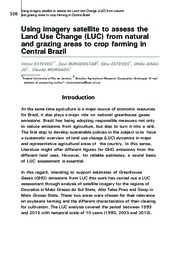Using imagery satellite to assess the Land Use Change (LUC) from natural and grazing areas to crop farming in Central Brazil.
Using imagery satellite to assess the Land Use Change (LUC) from natural and grazing areas to crop farming in Central Brazil.
Author(s): ESTEVES, V.; BUNGENSTAB, D.; ESTEVES, E.; ARAUJO, O.; MORGADO, C.
Summary: At the same time agriculture is a major source of economic resources for Brazil, it also plays a major role on national greenhouse gases emissions. Brazil has being adopting responsible measures not only to reduce emissions from agriculture, but also to turn it into a sink. The first step to develop sustainable policies in the subject is to have a systematic overview of land use change (LUC) dynamics in major and representative agricultural areas of the country. In this sense, Literature might offer different figures for GHG emissions from the different land uses. However, for reliable estimates, a sound basis of LUC assessment is essential. In this regard, intending to support estimates of Greenhouse Gases (GHG) emissions from LUC this work has carried out a LUC assessment through analysis of satellite imagery for the regions of Dourados in Mato Grasso do Sul State, Alto Teles Pires and Sinop in Mato Grosso State. These two areas were chosen for their relevance on soybeans farming and the different characteristics of their clearing for cultivation. The LUC analysis covered the period between 1993 and 2013 with temporal scale of 10 years (1993, 2003 and 2013).
Publication year: 2016
Types of publication: Paper in annals and proceedings
Unit: Embrapa Beef Cattle
Keywords: Brazil
Observation
Some of Embrapa's publications are published as ePub files. To read them, use or download one of the following free software options to your computer or mobile device. Android: Google Play Books; IOS: iBooks; Windows and Linux: Calibre.
Access other publications
Access the Agricultural Research Database (BDPA) to consult Embrapa's full library collection and records.
Visit Embrapa Bookstore to purchase books and other publications sold by Embrapa.

